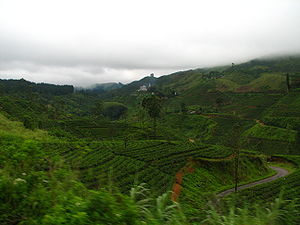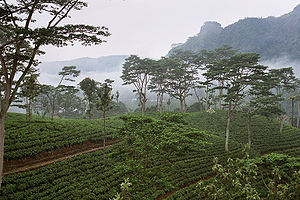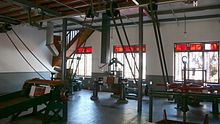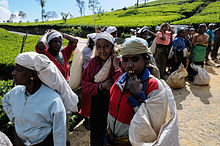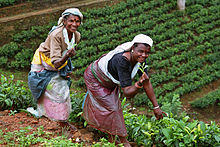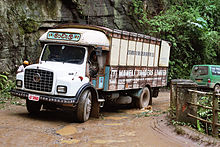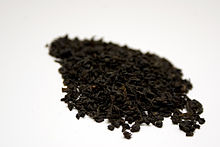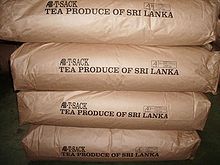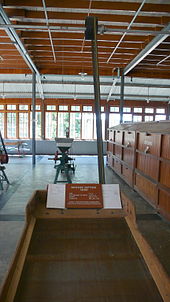- Tea production in Sri Lanka
-
Main articles: Economy of Sri Lanka and Sri Lanka
Tea production in Sri Lanka, formerly Ceylon, is of high importance to the Sri Lankan economy and the world market. The country is the world's fourth largest producer of tea and the industry is one of the country's main sources of foreign exchange and a significant source of income for laborers, with tea accounting for 15% of the GDP, generating roughly $700 million annually. In 1995 Sri Lanka was the world's leading exporter of tea, (rather than producer) with 23% of the total world export, but it has since been surpassed by Kenya. The tea sector employs, directly or indirectly over 1 million people in Sri Lanka, and in 1995 directly employed 215,338 on tea plantations and estates. The humidity, cool temperatures, and rainfall in the country's central highlands provide a climate that favors the production of high quality tea. The industry was introduced to the country in 1867 by James Taylor, the British planter who arrived in 1852.[1][2][3][4][5][6][7]
Contents
History
Pre-Tea era
Cinnamon was the first crop to receive government sponsorship in Ceylon, while the island was under Dutch control.[8] During the administration of Dutch governor Iman Willem Falck, cinnamon plantations were planted in Colombo, Maradana, and Cinnamon Gardens in 1769. The first British governor Frederick North prohibited private cinnamon plantations, thereby securing monopoly on cinnamon plantations for the East India Company. However, an economic slump in the 1830s in England and elsewhere in Europe affected the cinnamon plantations in Ceylon. This resulted in them being decommissioned by William Colebrooke in 1833. Finding cinnamon unprofitable, the British turned to coffee.
By 1825 the Ceylonese already had a knowledge of coffee. They started planting coffee as a garden crop and the first coffee plantation was started in Baddegama in Galle District. Although this venture failed due to the unsuitability of the area for the crop, George Bird became the first to start planting coffee on a commercial scale. After Bird began his coffee plantation in Singhapitiya, Gampola governor Edward Barnes also started a plantation in Gannoruwa. The demand and high price in the European market for coffee fueled the rush of coffee planting. Investors flocked to Ceylon from overseas and around 100,000 ha (386 sq mi) of rain forest was cleared to pave the way for coffee plantations. The term "Coffee rush" was coined to describe this developing situation in 1840.[8] In 1869 the coffee industry was still thriving in Ceylon but shortly afterwards, coffee plantations were devastated by a fungal disease called Hemileia vastatrix or coffee rust, better known as "coffee leaf disease" or "coffee blight".[9] The planters nicknamed the disease "devastating Emily"[10] when it was first identified in the Madolsima area in 1869. Production dipped rapidly as the disease set in and every effort failed to revive coffee production. Of 1700 coffee planters, only 400 remained on the island as the rest left for their home countries. The coffee crop died, marking an end of an era when most of the plantations on the island were dedicated to producing coffee beans. Planters experimented with cocoa and cinchona as alternative crops but failed due to a bug, Heloplice antonie, so that in the 1870s virtually all the remaining coffee planters in Ceylon switched to the production and cultivation of tea.[11] By the year 1900, only 11,392 acres (46 km2) were still under coffee cultivation.[12]
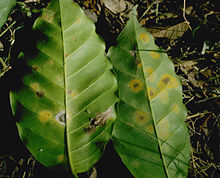 Hemileia vastatrix or "coffee rust" which brought the downfall of coffee production and transition to the tea industry.
Hemileia vastatrix or "coffee rust" which brought the downfall of coffee production and transition to the tea industry.
Foundation of tea plantations

In 1824 a tea plant was brought to Ceylon by the British from China and was planted in the Royal Botanical Gardens in Peradeniya for non-commercial purposes.[13] Further experimental tea plants were brought from Assam and Calcutta in India to Peradeniya in 1839 through the East India Company and over the years that followed. In 1839 the Ceylon Chamber of Commerce was also established followed by the Planters' Association of Ceylon in 1854.[13] In 1867, James Taylor marked the birth of the tea industry in Ceylon by starting a tea plantation in Loolecondera estate in Kandy in 1867. He began the tea plantation on an estate of just 19 acres (76,890 m2). In 1872 he started a fully equipped tea factory in the same Loolecondera estate and that year the first sale of Loolecondra tea was made in Kandy. In 1873, the first shipment of Ceylon tea, a consignment of some 23 lb (10 kg), arrived in London. Sir Arthur Conan Doyle remarked on the establishment of the tea plantations, “…the tea fields of Ceylon are as true a monument to courage as is the lion at Waterloo”.
Soon enough plantations surrounding Loolecondera such as Hope, Rookwood and Mooloya situated to the east and Le Vallon and Stellenberg to the south began transforming into tea plantations and were amongst the first tea estates to be established on the island.
The total population in Sri Lanka according to the census of 1871 was 2,584,780. The 1871 demographic distribution and population in the plantation areas is given below:[12]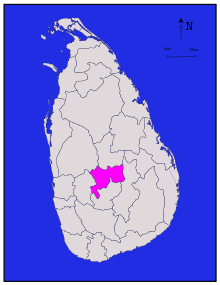 Kandy District, the heartland of tea production in Sri Lanka
Kandy District, the heartland of tea production in Sri Lanka
1871 Demographic Distribution District Total
populationNo. of
estatesEstate
population% of population
on estatesKandy District 258,432 625 81,476 31.53 Badulla District 129,000 130 15,555 12.06 Matale District 71,724 111 13,052 18.2 Kegalle District 105,287 40 3,790 3.6 Sabaragamuwa 92,277 37 3,227 3.5 Nuwara Eliya District 36,184 21 308 0.85 Kurunegala District 207,885 21 2,393 1.15 Matara District 143,379 11 1,072 0.75 Total 1,044,168 996 123,654 11.84 Growth and history of commercial production
 Henry Randolph Trafford, one of the pioneers of tea cultivation in Ceylon in the 1880s.
Henry Randolph Trafford, one of the pioneers of tea cultivation in Ceylon in the 1880s.
Tea production in Ceylon increased dramatically in the 1880s and by 1888 the area under cultivation exceeded that of coffee, growing to nearly 400,000 acres (1,619 km2) in 1899.[14] British figures such as Henry Randolph Trafford arrived in Ceylon and bought coffee estates in places such as Poyston, near Kandy in 1880, which was the centre of the coffee culture of Ceylon at the time.[14] Although he knew little about coffee, he had considerable knowledge in regards to tea cultivation and he is considered one of the pioneer tea planters in Ceylon.[14] By 1883, Trafford was the resident manager of numerous estates in the area, now switching to tea production.[14] By the late 1880s almost all the coffee plantations in Ceylon had been converted to tea. Similarly, coffee stores rapidly converted to tea factories in order to meet the increasing demand for tea. Technology for processing tea developed in the 1880s, after the manufacture of the first "Sirocco" tea drier by Samuel C. Davidson in 1877 and the manufacture of first tea rolling machine by John Walker & Co in 1880 set the conditions that would be required to make commercial tea production a reality.[13] This was consolidated in 1884 with the construction of the Central Tea Factory on Fairyland Estate (Pedro) in Nuwara Eliya.[13] As tea production in Ceylon progressed, new factories were constructed, introducing innovative methods of mechanization brought from England. Marshals of Gainsborough of Lancashire, the Tangyes Machine Company of Birmingham, and Davidsons of Belfast supplied the new tea factories with machinery which they still supply today.
Tea was increasingly sold at auction as its popularity grew. The first public Colombo Auction was held at the premises of Somerville & Co. on 30 July 1883, under the auspices of the Ceylon Chamber of Commerce.[13] One million tea packets were sold at the Chicago World's Fair in 1893. That same year the tea established a record price of £36.15 per lb at the London Tea Auctions. In 1894 the Ceylon Tea Traders Association was formed and today virtually all tea produced in Sri Lanka is conducted through this association and the Ceylon Chamber of Commerce. In 1896 the Colombo Brokers' Association was formed and in 1915 Thomas Amarasuriya became the first Ceylonese to be appointed as Chairman of the Planters' Association. In 1925 the Tea Research Institute was established in Ceylon to conduct research into maximising yields and methods of production. By 1927 tea production in the country exceeded 100,000 metric tons (110,231 short tons), almost entirely for export. A 1934 law prohibited the export of poor quality tea. The Ceylon Tea Propaganda Board was formed in 1932.
In 1938 the Tea Research Institute commenced work on vegetative propagation at St. Coombs Estate in Talawakele, and by 1940 it had developed a biological control (a parasitic wasp, Macrosentus homonae) to suppress the Tea Tortrix caterpillar, which had threatened the tea crop.[13][15] In 1941 the first Ceylonese tea broking house, M/s Pieris & Abeywardena, was established, and in 1944 the Ceylon Estate Employers' Federation was founded.[13] On October 1, 1951, export duty on tea was introduced and in 1955 the first clonal tea fields began cultivation.[13] In 1958 the State Plantations Corporation was established, and on June 1, 1959, Ad Valorem Tax was introduced for teas sold at the Colombo auctions.[13]
By the 1960s the total tea production and exports exceeded 200,000 metric tons (220,462 short tons) and 200,000 hectares (772 sq mi), and by 1965 Sri Lanka became the world's largest tea exporter for the first time.[13] In 1963 the production and exports of Instant Teas was introduced, and in 1966 the first International Tea Convention was held to commemorate 100 years of the tea industry in Sri Lanka. During 1971–1972, the government of Sri Lanka nationalized the tea estates owned by the British companies.[16] The state took over some 502 privately owned tea, rubber and coconut estates, and in 1975 it nationalized the Rupee and Sterling companies.[13] Land reform in Sri Lanka meant that no cultivator was allowed to own more than 50 acres (202,343 m2) for any purpose. In 1976 the Sri Lanka Tea Board was founded as were other bodies, such as the Janatha Estate Development Board (JEDB), Sri Lanka State Plantation Corporation (SLSPC) and the Tea Small Holding Development Authority (TSHDA) to supervise the state's acquired estates.[12] It was in 1976 that the export of tea bags also commenced.[13]
In 1980 Sri Lanka became the official supplier of tea at the 1980 Moscow Summer Olympic Games, in 1982 at the 12th Commonwealth Games in Brisbane and again in 1987 at Expo 88 in Australia.[13] In 1981, the import of teas for blending and re-exports was introduced and in 1982 the production and export of green tea commenced in Sri Lanka.[13] CTC teas commenced in the country in 1983. In 1992 the 125th anniversary of the industry was celebrated in an international convention in Colombo. On December 21, 1992 the Export Duty and Ad Valorem Tax were abolished and the Tea Research Board was established to further research into tea production.[13] In 1992-1993 many of the government-owned tea estates which had been nationalized in the early 1970s were privatized again.[13] Heavy losses to the industry had been incurred under state management, and the government made the decision to return its plantations to private management with the sale of its 23 state-owned plantations.
By 1996, Sri Lanka's tea production had exceeded 250,000 metric tons (275,578 short tons), growing to over 300,000 metric tons (330,693 short tons) by the year 2000.[13] In 2001 the first on-line sales of tea commenced, sold by Forbes & Walker Ltd.,[17] at the Colombo Tea Auctions.[13] A Tea Museum was established in Kandy and in 2002 the Tea Association of Sri Lanka was formed.[13] According to the minister of plantation industries, Lakshman Kiriella, the Tea Association of Sri Lanka is "intended to transform the 135-year-old industry into a truly global force and facilitate a greater private sector role in strategy formulation, and implementation, and plantation industries".[18] The association, which works with those that preceded it in Sri Lanka, represents tea producers, traders, exporters, smallholders, private factory owners and brokers, and is funded largely through Asian Development Bank.[18]
Labour
Directly and indirectly, over one million Sri Lankans are employed in the tea industry. A large proportion of the workforce is young women and the minimum working age is twelve. As tea plantations grew in Sri Lanka and demanded extensive labour, finding an abundant workforce was a problem for planters.[8] Sinhalese people were reluctant to work in the plantations. Indian Tamils were brought to Sri Lanka at the beginning of the coffee plantations. Immigration of Indian Tamils steadily increased and by 1855 there were 55,000 new immigrants. By the end of the coffee era there were some 100,000 in Sri Lanka.[8] Young girls typically follow their mothers, grandmothers and older sisters on the plantations, and the women are also expected to perform most of the domestic duties.[19] They live in housing known as "lines", a number of linearly attached houses with just one or two rooms.[19] This housing system and the environmental sanitation conditions are generally poor for laborers in the plantation sector.[19] There are typically 6 to 12 or 24 line rooms in one line barrack.[19] Often rooms for laborers are without windows and there is little or no ventilation and as many as 6 to 11 members may often live in one room together.[19] In the housing system for plantation workers in Sri Lanka, women and girls have no privacy from the male workers, which places them at a higher risk for sexual harassment.[19] In June 2007, a study conducted in the Nuwara Eliya tea growing area revealed that the serious lack of privacy has led several women to commit suicide, especially newly wedded women.[19] According to studies by Christian Aid, the female Indian Tamil plantation workers are particularly at risk from discrimination and victimization.[7] Some concern towards women's rights have been made in regards to the female plantation workers in Sri Lanka, resulting in some 85 neighborhood women's groups being formed across the country, educating them in gender, leadership and preventing violence against women.[19]
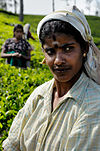 A Tamil woman working in a plantation.
A Tamil woman working in a plantation.
The tea plantation is structured in a social hierarchy and the women, who often consist of 75%-85% of the work force in the tea industry, are at the lowest social strata and are powerless.[19] This is not unusual as the subordinance of women under men is present domestically and in the social community in many parts of Sri Lanka.[19] Wages are typically particularly low. In Nuwara Eliya, women were once paid as little as 7 rupees per kilogram, the equivalent of 4 pence, or 7 cents, and many must complete 16 kilograms a day.[7] Given the social stratification in Sri Lanka's past, the pay had to be collected by a husband or father.[7] The men who work on the tea plantations typically cut down trees or operate machinery and are better paid at 155 rupees (82p) a day and finish the day hours earlier.[7] Due to the severely low wages, industrial action took place in 2006.[20] Wages in the tea sector were increased with the average daily wage earned in the sector now significantly higher at 378 rupees for men and 261 for women in some places.[20] However studies have revealed that poverty is still a major problem and despite the tea industry employing a large number of poor people, employment has failed to alleviate poverty since workers are often highly uneducated and unskilled.[20] Poverty levels on plantations have consistently been higher than the national average and although overall poverty in Sri Lanka has declined in the last thirty years, it is now significantly concentrated in rural areas.[20] Poverty in the estate sector has been reported to be increasing with roughly one in three suffering from poverty, rising from 30 percent in 2002 to 32 percent in 2006/07.[20] Likewise, Nuwara Eliya showed a significant increase in poverty among workers from 2002 to 2006/07 from 22.6 percent in 2002 to 33.8 percent in 2006/07.[20] But by no means is employment secure in the tea sector in Sri Lanka. Like other industries, job security in the tea industry has been threatened by the current financial crisis. In Sri Lanka over 50,000 private sector employees are expected to lose their jobs in 2009 due to the current slump.[21]
Cultivation and processing
Over 188,175 hectares (727 sq mi) or approximately 4% of the country’s land area is covered in tea plantations. The crop is best grown at high altitudes of over 2,100 m (6,890 ft), and the plants require an annual rainfall of more than 100–125 cm (39–49 in).
Tea is cultivated in Sri Lanka using the ‘contour planting’ method, where tea bushes are planted in lines in coordination with the contours of the land, usually on slopes. For commercial manufacture the ‘flush’ or leaf growth on the side branches and stems of the bush are used. Generally two leaves and a bud, which have the flavour and aroma, are skilfully plucked, usually by women.[22] Sri Lanka is one of the few countries where each tea leaf is picked by hand rather than by mechanization; if machinery were used, often a considerable number of coarse leaves and twigs could be mixed in, adding bulk but not flavor to the tea.[22] With experience the women acquire the ability to pluck rapidly and set a daily target of around 15 to 20 kg (33 to 44 lb) of tea leaves to be weighed and then transported to the nearby tea factory. Tea plants in Sri Lanka require constant nurturing and attention. An important part of the process is taking care of the soils with the regular application of fertilizer. Younger plants are regularly cut back 10–15 cm (4–6 in) from the ground to encourage lateral growth and are pruned very frequently with a special knife.
The tea factories found on most tea estates in Sri Lanka are crucial to the final quality and value of manufactured tea. After plucking, the tea is very quickly taken to the muster sheds to be weighed and monitored under close supervision, and then the teas are brought to the factory.[22] A tea factory in Sri Lanka is typically a multi-storied building and located on tea estates to minimize the costs and time between plucking and tea processing. The tea leaves are taken to the upper floors of the factories where they are spread in troughs, a process known as withering, which removes excess moisture in the leaf. Once withered, the tea leaves are rolled, twisted and parted, which serves as a catalyst for the enzymes in the leaves to react with the oxygen in the air, especially with the production of black tea.
The leaves are rolled on circular brass or wooden battened tables and are placed in a rotating open cylinder from above. After rolling is finished, the leaf particles are spread out on a table where they begin to ferment upon being exposed to heat. However, the preliminary heat is from the natural air temperature, so fermentation times fluctuate according to the temperature and humidity. Regulating the temperature, humidity and the duration of fermentation times requires a great deal of attention, and failure to follow the exact guidelines will make the flavor of the tea disappear.[22] As oxidization occurs the colour of the leaf changes from a green to a bright coppery color. It is now that artificial heat comes into play as the fermented leaf is inserted into a firing chamber to prevent further chemical reactions from taking place. The tea leaves are fired to retain the flavour after the fermentation process is complete.[22] Again the regulation of the temperature plays an important role in the final quality of the tea, and on completion the tea will become black and harder.
Grading (ordered by size in Sri Lanka) then takes place as the tea particles are sorted into different shapes and sizes by sifting them through meshes. No artificial preservatives are added at any stage of the manufacturing process and sub-standard tea which fails to initially comply with standards is rejected regardless of the quantity and value.[22] Finally, the teas are weighed and packed into tea chests or paper sacks and then given a close inspection. The tea is then sent to the local auction and transported to the tea brokering companies.[22] At the stage of exporting the Sri Lanka Tea Board will check and sample each shipment after the completion of packing to ensure that the finest quality tea is exported and then it is finally shipped in various forms of packing to many parts of the world.[22]
Cultivation areas
The major tea growing areas are Kandy and Nuwara Eliya in Central Province, Badulla, Bandarawela and Haputale in Uva Province, Galle, Matara and Mulkirigala in Southern Province, and Ratnapura and Kegalle in Sabaragamuwa Province.
There are mainly six principal regions planting tea - Nuwara Eliya, Dimbula, Kandy Uda Pussellawa, Uva Province and Southern Province.[23] Nuwara Eliya is an oval shaped plateau at an elevation of 6,240 feet (1,902 m). Nuwara Eliya tea produces a unique flavour.
Dimbula was one the first areas to be planted in the 1870s. An elevation between 3,500 to 5,000 ft (1,067 to 1,524 m) defines this planting area.[24] South-western monsoon rain and cold weather from January to March are determining factors of flavour. Eight subdistricts of Dimbula are Hatton/Dickoya, Bogawanthalawa, Upcot/Maskeliya, Patana/Kotagala, Nanu Oya/Lindula/Talawakele, Agarapatana, Pundaluoya and Ramboda.
Kandy is famous for Mid-grown tea. The first tea plantations were established here. Tea plantations are located at elevations of 2,000 to 4,000 ft (610 to 1,219 m).[24] Pussellawa/Hewaheta and Matale are the two main subdistricts of the region. Uda Pussellawa is situated between Nuwara Eliya and Uva Province. Northwest monsoons prevail in this region. Plantations near Nuwara Eliya have a range of rosy teas. The two subdistricts are Maturata and Ragala/Halgranoya.
Uva area's teas have quite a distinctive flavour and are widely used for blends. The elevation of tea plantations range from 3,000 to 5,000 ft (914 to 1,524 m).[24] Being a large district, Uva has a number of subdistricts, Malwatte/Welimada, Demodara/Hali-Ela/Badulla, Passara/Lunugala, Madulsima, Ella/Namunukula, Bandarawela/Poonagala, Haputale, and Koslanda/Haldummulla.
Low-grown tea mainly originates from southern Sri Lanka. These teas are grown from sea level to 2,000 ft (610 m), and thrive in fertile soils and warm conditions.[24] These areas are spread across four main subdistricts, Ratnapura/Balangoda, Deniyaya, Matara, and Galle.
The high-grown tea thrives above 1,200 m (3,937 ft) of elevation, warm climate and sloping terrain.[24] Hence this type is common in the Central Highlands. Mid-grown tea is found in the 600–1,200 m (1,969–3,937 ft) altitude range. Various types of tea are blended to obtain the required flavour and colour. Uva Province, and Nuwara Eliya, Dimbuala and Dickoya are the areas where mid-grown tea originates. Low-grown tea is stronger and less-subtle in taste and is produced in Galle, Matara and Ratnapura areas.
Registered tea production by elevation in Sri Lanka
Registered tea production in hectares and total square miles by elevation category in Sri Lanka, 1959-2000:[12]
Year High
altitude
hectaresMedium
altitude
hectaresLow
altitude
hectaresTotal
hectaresTotal
square
miles1959 74,581 66,711 46,101 187,393 723.5 1960 79,586 69,482 48,113 197,181 761.3 1961 76,557 97,521 63,644 237,722 917.8 1962 76,707 97,857 64,661 239,225 923.7 1963 76,157 95,691 65,862 237,710 917.8 1964 81,538 92,281 65,759 239,578 925.0 1965 87,345 92,806 60,365 240,516 928.6 1966 87,514 93,305 60,563 241,382 932.0 1967 87,520 93,872 60,945 242,337 935.7 1968 81,144 99,359 61,292 241,795 933.6 1969 81,092 98,675 61,616 241,383 932.0 1970 77,549 98,624 65,625 241,798 933.6 1971 77,936 98,624 65,625 242,185 935.1 Year High
altitude
hectaresMedium
altitude
hectaresLow
altitude
hectaresTotal
hectaresTotal
square
miles1972 77,639 98,252 65,968 241,859 933.8 1973 77,793 98,165 66,343 242,301 935.5 1974 77,693 97,875 66,622 242,190 935.1 1975 79,337 98,446 64,099 241,882 933.9 1976 79,877 94,338 66,363 240,578 928.9 1977 79,653 94,835 67,523 242,011 934.4 1978 79,628 95,591 68,023 243,242 939.2 1979 78,614 97,084 68,401 244,099 942.5 1980 78,786 96,950 68,969 244,705 944.8 1981 78,621 96,853 69,444 244,918 945.6 1982 77,769 96,644 67,728 242,141 934.9 1983 71,959 90,272 67,834 230,065 888.3 1984 74,157 90,203 63,514 227,874 879.8 Year High
altitude
hectaresMedium
altitude
hectaresLow
altitude
hectaresTotal
hectaresTotal
square
miles1985 74,706 89,175 67,769 231,650 894.4 1986 73,206 85,216 64,483 222,905 860.6 1987 72,773 84,445 64,280 221,498 855.2 1988 72,901 84,227 64,555 221,683 855.9 1989 73,110 84,062 64,938 222,110 857.6 1990 73,138 83,223 65,397 221,758 856.2 1991 73,331 82,467 65,893 221,691 856.0 1992 74,141 85,510 62,185 221,836 856.5 1994 51,443 56,155 79,711 187,309 723.2 1995 51,443 56,155 79,711 187,309 723.2 1996 52,272 56,863 79,836 188,971 729.6 1997 51,444 58,155 79,711 189,310 730.9 1998 51,444 58,155 79,711 189,310 730.9 2000 52,272 56,863 79,836 188,971 729.6 Infrastructure
After the introduction of tea, the Sri Lankan economy transformed from a traditional economy to a plantation economy.[8] Many Europeans migrated to Sri Lanka as planters and Indian Tamils were brought to the island as estate laborers.
At the time of the Kandyan Kingdom it was policy not to build roads for reasons of strategic defense.[8] Therefore when the plantations started, there was very little infrastructure in place in the hill country. Transporting the products to the Colombo port was a major problem. Therefore the Sri Lankan government undertook a massive program of road, rail and urban development in the plantation areas. Governor Sir Edward Barnes pioneered the building of roads. During his government, Captain Dawson, Major Skinner and others in the public works department completed the Colombo-Kandy road.[25][26]
Building roads did suffice to solve the transportation problem. Finding enough carts was difficult and it was a slow medium.[27] The Ceylon Planters Association was founded in 1854 in protest of the government's reduction of expenditures on highways. This association lobbied the government to build and maintain roads. Although construction of the first rail line commenced in 1858, the line did not open until 1865 due to these protests.[27][28]
The railway was originally known as Ceylon Government Railways. The Main Line was constructed from Colombo to Ambepussa, 54 km (34 mi) to the east. The railway was initially built to transport coffee and tea from the hill country to Colombo for export. For many years, transporting such goods was the main source of income on the line. The first train ran on 27 December 1864. The line was officially opened for traffic on 2 October 1865. The Main Line was extended in stages with service to Kandy in 1867, to Nawalapitiya in 1874, to Nanu Oya in 1885, to Bandarawela in 1894, and to Badulla in 1924.
Other lines were completed in due course to link the country: the Matale Line in 1880, the Coast Line in 1895, the Northern Line in 1905, the Mannar Line in 1914, the Kelani Valley Line in 1919, the Puttalam Line in 1926, and the Batticaloa and Trincomalee Lines in 1928. The rail lines helped develop what had hitherto been an undeveloped country. Today, instead of transporting tea to the ports, the railways primarily transport passengers, especially commuters to and from Colombo.
Product
Ceylon black tea
Ceylon black tea is one of the country's specialities. It has a crisp aroma reminiscent of citrus, and is used both unmixed and in blends. It is grown on numerous estates which vary in altitude and taste.
Ceylon green tea
Ceylon green tea is mainly made from Assamese tea stock. It is grown in Idalgashinna in Uva Province. Ceylon green teas generally have the fuller body and the more pungent, rather malty, nutty flavour characteristic of the teas originating from Assamese seed stock. The tea grade names of most Ceylon green teas reflect traditional Chinese green tea nomenclature, such as tightly rolled gunpowder tea, or more open leaf tea grades with Chinese names like Chun Mee. Overall, the green teas from Sri Lanka have their own characteristics at this time - they tend to be darker in both the dry and infused leaf, and their flavour is richer; this could change in the future. As market demand preferences change, the Ceylon green tea producers start using more of the original Chinese, Indonesian, Japanese and Brazilian seed base, which produces the very light and sparkling bright yellow colour and more delicate, sweet flavour with which most of the world market associates green teas. At this time, Sri Lanka remains a very minor producer of green teas and its green teas, like those of India and Kenya, remain an acquired taste.
Ceylon white tea
Ceylon white tea, also known as "silver tips" is highly prized, and prices per kilogram are significantly higher than other teas. The tea was first grown at Nuwara Eliya near Adam's Peak between 2,200–2,500 meters (7,218–8,202 ft). The tea is grown, harvested and rolled by hand with the leaves dried and withered in the sun. It has a delicate, very light liquoring with notes of pine & honey and a golden coppery infusion. 'Virgin White Tea' is also grown at the Handunugoda Tea Estate near Galle in the south of Sri Lanka.
International market and prices
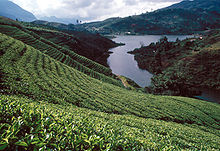 A tea plantation near Nuwara Eliya in a medium altitude area.
A tea plantation near Nuwara Eliya in a medium altitude area.
Sri Lankan tea continued to have international success into the 2000s. In 2001, despite falling tea prices in every major tea exporting country and increasing competition, Sri Lanka retained its position as the world's top tea exporter by selling a record 294 million kilograms (648.2 million lbs) in 2001 compared to 288 million kilograms (634.9 million lbs) in 2000.[29] World tea production in 2001 rose 3.7% to 3.022 million tonnes (3.331 million short tons), but in Sri Lanka tea exports rose to an all-time high of $658 million from $595 million the previous year.[29] Currently, however, Sri Lanka, whilst the world's largest exporter of tea, is far behind India and China in terms of total production.
In 2003 the government in Sri Lanka sought to protect the country's near $700 million tea industry during the 2003 Iraq War. The war in Iraq caused panic, particularly among small-scale Sri Lankan tea growers who represent 69% of all tea production in Sri Lanka, who demanded that the government bail them out.[30] Iraq buys up to 15% of Sri Lanka's tea, and a third of this would enter the country illegally on small boats from Dubai as well as into neighbouring countries such as Iran.[30] Exporters called for the government to assist them with concessionary bank loans and some tea factory owners in Sri Lanka demanded a moratorium on electricity bill payments.[30] Prices fell in Colombo as a result of the crisis.[30] Plantations Minister Lakshman Kiriella responded, saying, "tea promoters would receive diplomatic postings in Sri Lankan missions abroad to give an extra push to the island's 'green gold'".[30] $15 million was funded to promote Sri Lankan brands on international markets during the Iraq war.[30] Later in 2003 the island suffered severe floods in the lower growing tea areas of Sri Lanka.[31] However production still increased slightly by 1.3 percent to 309,000 tonnes (340,614 short tons) in 2004, as the crop recovered.[31] Kenya surpassed Sri Lanka as the largest exporter of tea with an 8.9 percent growth in exports for the year totalling nearly 293,000 tonnes (322,977 short tons).[31] In 2004 actual tea production in Kenya had increased by more than 11 percent to reach 328,000 tonnes (361,558 short tons), as a result of a good harvesting season, wealth and improved processing facilities.[31]
The Sri Lankan tea industry continued to grow into 2007 and 2008. Tea production hit a record 318.47 million kilograms (702.1 million lbs) in 2008, up from 305.2 million kilograms (672.9 million lbs) produced in 2007.[32] In 2008 export earnings struck a record high of $1.23 billion for the full year, up from $1.02 billion in 2007.[32] However, more recently the industry, like many others across the world, has suffered from the contemporary global financial crisis.[32] The Sri Lanka Tea Board revealed in March 2009 that the industry had suffered a 30 percent drop in overseas sales in January 2009.[32] The downfall in tea production has been felt not only by Sri Lanka but by all the major tea producing nations.[33] Total volume of tea exports fell 25 percent to 17.76 million kilograms (39.2 million lbs) and sales from tea shipments fell to 6.9 billion rupees ($61.37 million ) in January, compared to 9.8 billion rupees in the same period a year earlier.[32] Prices have collapsed to an average of $2.65 per kilogram ($1.20/lb) from record highs of $4.26 per kilogram ($1.93/lb) experienced between January and September 2008.[32] Drought has also been a contributing factor to the 2009 crisis in Sri Lankan tea as it has in India.[33] The Sri Lankan industry has been hit worst though with a fall of 8.7 million kg (19.2 million lbs) produced in January 2009.[33]
Main destination of Sri Lankan teas
The most important foreign markets for Sri Lankan tea are the former Soviet bloc countries of the CIS, the United Arab Emirates, Russia, Syria, Turkey, Iran, Saudi Arabia, Iraq, the UK, Egypt, Libya and Japan.[29]
The most important foreign markets for Sri Lankan tea are as follows, in terms of millions of kilograms and millions of pounds imported. The figures were recorded in 2000:[12]
Total Exports
CountryMillion
kilogramsMillion
poundsPercent
of totalCIS Countries 57.6 127.0 20 UAE 48.1 106.0 16.7 Russia 46.1 101.6 16.01 Syria 21.5 47.4 7.47 Turkey 20.3 44.8 7.05 Iran 12.5 27.6 4.34 Saudi Arabia 11.4 25.1 3.96 Iraq 11.1 24.5 3.85 UK 10.2 22.5 3.54 Egypt 10.1 22.3 3.51 Libya 10.0 22.0 3.47 Japan 8.3 18.3 2.88 Germany 5.0 11.0 1.74 Others 23.7 52.2 8.23 Total 288 634.9 100 Branding and grading
 Sign of Quality for Pure Ceylon Tea.
Sign of Quality for Pure Ceylon Tea.
Ceylon tea is divided into three groups: High or Upcountry (Udarata), Mid country (Medarata), and Low country (Pahatha rata) tea, based on the geography of the land on which it is grown.
Tea produced in Sri Lanka carries the "Lion Logo"[34] on its packages, which indicates that the tea was produced in Sri Lanka. The use of the Lion Logo is closely monitored by the Sri Lanka Tea Board,[35] which is the governing body of the tea industry in Sri Lanka. If a tea producer demands to use the Lion Logo on his packaging, they need to gain permission from the Sri Lanka Tea Board. The tea board then performs a strict inspection procedure, the passing of which allows the producer to use the logo, along with the "Pure Ceylon Tea - Packed in Sri Lanka" slogan on their tea packaging. Each and every consignment is thoroughly inspected by Sri Lanka Tea board officers before being shipped. Therefore the Lion Logo and the wording is indeed the assurance of the origin of the tea and of its quality.
Most of the Sri Lankan tea exporters now focus on adding more value to the exports rather than exporting raw tea. The name "Ceylon Tea" or "Sri Lankan tea" is still regarded as a sign of quality throughout the world.
Grading names which are used in Sri Lanka to classify its teas are not by any means the indication of its quality but indicate its size and appearance. Mainly there are two categories. They are "Leaf grades" and "Smaller broken grades". Leaf grades refers to the size and appearance of the teas that were produced during Sri Lanka's colonial era (which are still being used) and the other refers to the modern tea style and appearance.
Institutions and research
Ceylon Tea Museum
The Sri Lanka Tea Board opened a Tea Museum in Hantana, Kandy in 2001. Although exhibits are not abundant they do provide a valuable insight into how tea was manufactured in the early days. Old machinery, some dating back more than a century, has been lovingly restored to working order. The first exhibit that greets visitors is the Ruston and Hornsby developed diesel engine, as well as other liquid fuel engines, located in the Engine Room on the ground floor of the museum. Power for the tea estates were also obtained by water driven turbines.
The museum's "Rolling Room" offers a glimpse into the development of manufacturing techniques, with its fascinating collection of rollers. Here the showpiece is the manually operated 'Little Giant Tea Roller'.
Periodontal research
Beginning in the early 1970s, two researchers from the National Institute of Dental Research in Bethesda, Maryland conducted a series of research projects in which they arranged a longitudinal study group of a large number of Tamil tea laborers who worked at the Dunsinane and Harrow Tea Estates, 50 miles from Kandy. This landmark study was possible because the population of tea laborers were known to have never employed any conventional oral hygiene measures, thereby providing some insight into the natural history of periodontal disease in man.[36]
Further reading
- George Thornton Pett (1899). The Ceylon Tea-Makers' Handbook. The Times of Ceylon Steam Press, Colombo. http://www.archive.org/stream/ceylonteamakersh00pettrich#page/n3/mode/2up.
See also
- James Taylor (Ceylon)
- Loolecondera
- Thomas Lipton
- Handunugoda Tea Estate
References
- ^ "TED Case Studies - Ceylon Tea". American University, Washington, DC. http://www.american.edu/ted/ceylon-tea.htm.
- ^ "Sri Lanka tops tea sales". BBC. 01 February, 2002. http://news.bbc.co.uk/2/hi/business/1796478.stm.
- ^ "Sri Lanka Tea Tour". The Tea Association of the USA. August 11–17, 2003. http://www.teausa.com/general/teatour.cfm%20.
- ^ "Role of Tea in Development in Sri Lanka". United Nations Economic and Social Commission for Asia and the Pacific. http://www.unescap.org/drpad/publication/integra/volume3/srilanka/3sr01a.htm.
- ^ "South Asia Help for Sri Lanka's tea industry". BBC News. April 4, 1999. http://news.bbc.co.uk/2/hi/south_asia/311663.stm.
- ^ "Sri Lanka moves to protect tea industry". BBC News. 19 February 2003. http://news.bbc.co.uk/2/hi/business/2779267.stm.
- ^ a b c d e "Just 64p a day for tea pickers in Sri Lanka". BBC News. 20 September 2005. http://www.bbc.co.uk/oxford/content/articles/2005/09/12/jenny_august.shtml.
- ^ a b c d e f (Sinhala) de Silva, Rasangika (2005). "Sri Lankawe Te Wagawe Arambaya". Sri Lankawe Te Ithihasaya (1st ed.). Samanthi Publishers. pp. 27. ISBN 955-8596-32-9.
- ^ Steiman, Shawn. "Hemileia vastatrix". Coffee Research.org. http://www.coffeeresearch.org/agriculture/hemileiavastatrix.htm. Retrieved April 25, 2009.
- ^ Watson, Mike (Thursday, 18 September 2008). "Why Sri Lanka is everyone's cup of tea". lankamission.org. yorkshireeveningpost.co.uk. http://www.lankamission.org/index2.php?option=com_content&do_pdf=1&id=869. Retrieved 2009-04-26.
- ^ "Introduction and Historical Impact of Plant Health Problems". The Connecticut Agricultural Experiment Station. http://vvv.caes.state.ct.us/PlantPestHandbookFiles/pphIntroductory/pphdisease.htm. Retrieved April 25, 2009.
- ^ a b c d e Holsinger, Monte (2002). "Thesis on the History of Ceylon Tea". History of Ceylon Tea. http://www.historyofceylontea.com/feature-articles.asp. Retrieved April 25, 2009.
- ^ a b c d e f g h i j k l m n o p q r s "History of Ceylon tea". Eswaran Tea. http://www.eswaran.com/History.pdf. Retrieved April 21, 2009.
- ^ a b c d Baxendale, James. "Henry Randolph Trafford:An Early Tea Planter in Ceylon". History of Ceylon Tea. http://www.historyofceylontea.com/feature-article2.asp. Retrieved April 21, 2009.
- ^ W.W.D. Modder, ed., Twentieth Century Tea Research in Sri Lanka (1925-2000) (Talawakalle, Sri Lanka : The Tea Research Institute of Sri Lanka, 2003).
- ^ "The rise of the Ceylon Tea Industry James Taylor and the Loolecondera Estate". Official Website of the Government of Sri Lanka. http://www.priu.gov.lk/news_update/features/20011016Ceylon_Tea_Industry.htm.
- ^ "Sri Lankan Tea Brokers". Forbes & Walker Tea Brokers Ltd.. http://www.forbesteaportal.com/Insidepages/AboutTea/historyoftea.html. Retrieved July 28, 2009.
- ^ a b "Historical Tea association form in Sri Lanka". World News. 2003. http://www.thefreelibrary.com/Historical+Tea+association+form+in+Sri+Lanka.+(World+News)-a0103381818. Retrieved April 21, 2009.
- ^ a b c d e f g h i j Victor, Stella (December 10, 2007). "Working with men in Sri Lanka's tea plantations". Open Democracy. http://www.opendemocracy.net/blog/5050/sri_lankas_tea_plantations_working_with_men. Retrieved April 25, 2009.
- ^ a b c d e f "Sri Lankan tea pluckers not reaping benefits: study". Lanka Business Online. June 15, 2006. http://www.lankabusinessonline.com/fullstory.php?nid=1973541948. Retrieved April 25, 2009.
- ^ "Global recession hits Lanka: Companies cut workforce". Lanka Newspapers.com. March 17, 2009. http://www.lankanewspapers.com/news/2009/3/41052.html. Retrieved April 25, 2009.
- ^ a b c d e f g h "Tea producing process". Ceylon Black Tea. http://www.ceylonblacktea.com/tea_producing_process.html. Retrieved April 25, 2009.
- ^ "Tea Areas". pureceylontea.com. Sri Lanka Tea Board. http://www.pureceylontea.com/teaareas.htm. Retrieved 2009-04-23.
- ^ a b c d e "Tea growing areas in Sri Lanka". Ceylon Black Tea. http://www.ceylonblacktea.com/tea_growing_areas_in_sri_lanka.html. Retrieved April 25, 2009.
- ^ (Sinhala) Abhayawardhana, H.A.P. (2004). Kandurata Praveniya. Central Bank of Sri Lanka. pp. 140. ISBN 955-575-092-2.
- ^ "The great road-maker arrives". sundaytimes.lk. The Sunday Times. Sunday, January 14, 2007. http://sundaytimes.lk/070114/FunDay/heritage.html. Retrieved 2009-04-23.
- ^ a b (Sinhala) Rajapaksha, Sirisena (2001). Sri Lankawe Dumriya Gamanagamanaya (1st ed.). Author Publication. pp. 25. ISBN 955-97395-0-6.
- ^ Ratnasinghe, Aryadasa (3 January 1999). "A historic journey in 1864". The Sunday Times. http://sundaytimes.lk/990103/plus12.html. Retrieved 2009-04-23.
- ^ a b c "Sri Lanka tops tea sales". BBC. February 1, 2002. http://news.bbc.co.uk/1/hi/business/1796478.stm. Retrieved April 25, 2009.
- ^ a b c d e f "Sri Lanka moves to protect tea industry". BBC. February 19, 2003. http://news.bbc.co.uk/1/hi/business/2779267.stm. Retrieved April 24, 2009.
- ^ a b c d "World tea production reaches new highs". Food and Agriculture Organization. July 14, 2005. http://www.fao.org/newsroom/en/news/2005/105404/index.html. Retrieved April 25, 2009.
- ^ a b c d e f "Sharp fall in Sri Lanka tea exports". The Daily Mirror (Sri Lanka). March 5, 2009. http://www.dailymirror.lk/DM_BLOG/Sections/frmNewsDetailView.aspx?ARTID=42407. Retrieved April 25, 2009.[dead link]
- ^ a b c "Dry spell takes a toll on global tea production". The Economic Times of India. March 30, 2009. http://economictimes.indiatimes.com/Markets/Commodities/Dry-spell-takes-a-toll-on-global-tea-production/articleshow/4336801.cms. Retrieved April 25, 2009.
- ^ "Lion Logo". Sri Lanka Tea Board. http://www.pureceylontea.com/lionlogo.htm. Retrieved April 21, 2009. "Overseas Importers/packers are not allowed to use the Lion Logo on their tea packs even if the packs contain pure Ceylon Tea."
- ^ "Pure Ceylon Tea". Sri Lanka Tea Board. http://www.pureceylontea.com/. Retrieved April 21, 2009.
- ^ Löe, H, et al. Natural history of periodontal disease in man. J Clin Perio 1986;13:431-440.
External links
- Taylor, Lipton and the Birth of Ceylon Tea
- Jafferjee & Sons Exporters of Pure Ceylon Tea
- Akbar Tea official website
- Helping Sri Lanka's Forgotten Tea Workers Catholic Relief Services
- Documentary on the tea and rubber plantations of Sri Lanka: To Escape or Maximise? The estate workers' dilemma, Center for Poverty Analysis (CEPA), 2008
- Official web site of the Sri Lanka Tea Board
Tea Black tea Oolong tea - Bai Ji Guan
- Red Robe
- Darjeeling Oolong
- Dongding (Tung-ting)
- Dong Fang Mei Ren
- Huangjin Gui (Golden Osmanthus)
- Qilan tea
- Pouchong
- Rou Gui
- Shui Jin Gui
- Shui Hsien (Shui Xian)
- Tie Luohan
- Tieguanyin (Iron Goddess)
Green tea - Aracha
- Bancha
- Green Spiral
- Chun Mee
- Da Fang
- Genmaicha
- Liuan Leaf
- Gunpowder
- Gyokuro
- Hojicha
- Hou Kui
- Huang Shan Mao Feng
- Hyson
- Kabusecha
- Kamairicha
- Konacha
- Kukicha
- Longjing (Dragon Well)
- Matcha
- Mao Jian
- Mecha
- Meng Ding Gan Lu
- Sencha
- Shincha
- Tamaryokucha
White tea Yellow tea Post-fermented tea Blended and
flavoured teasTea culture Tea beverages Other - Camellia sinensis (tea plant)
- Tea bag
- Teapot
- Consumption
- Flowering tea
- Glass-holder
- Health effects
- Tea processing
- Samovar
- Tea brick
- Tea garden
- Tea house
- Tea tasting
- Teakettle
See also Categories:- Sri Lankan tea
- Agriculture in Sri Lanka
- Economy of Sri Lanka
- Tea production
Wikimedia Foundation. 2010.

